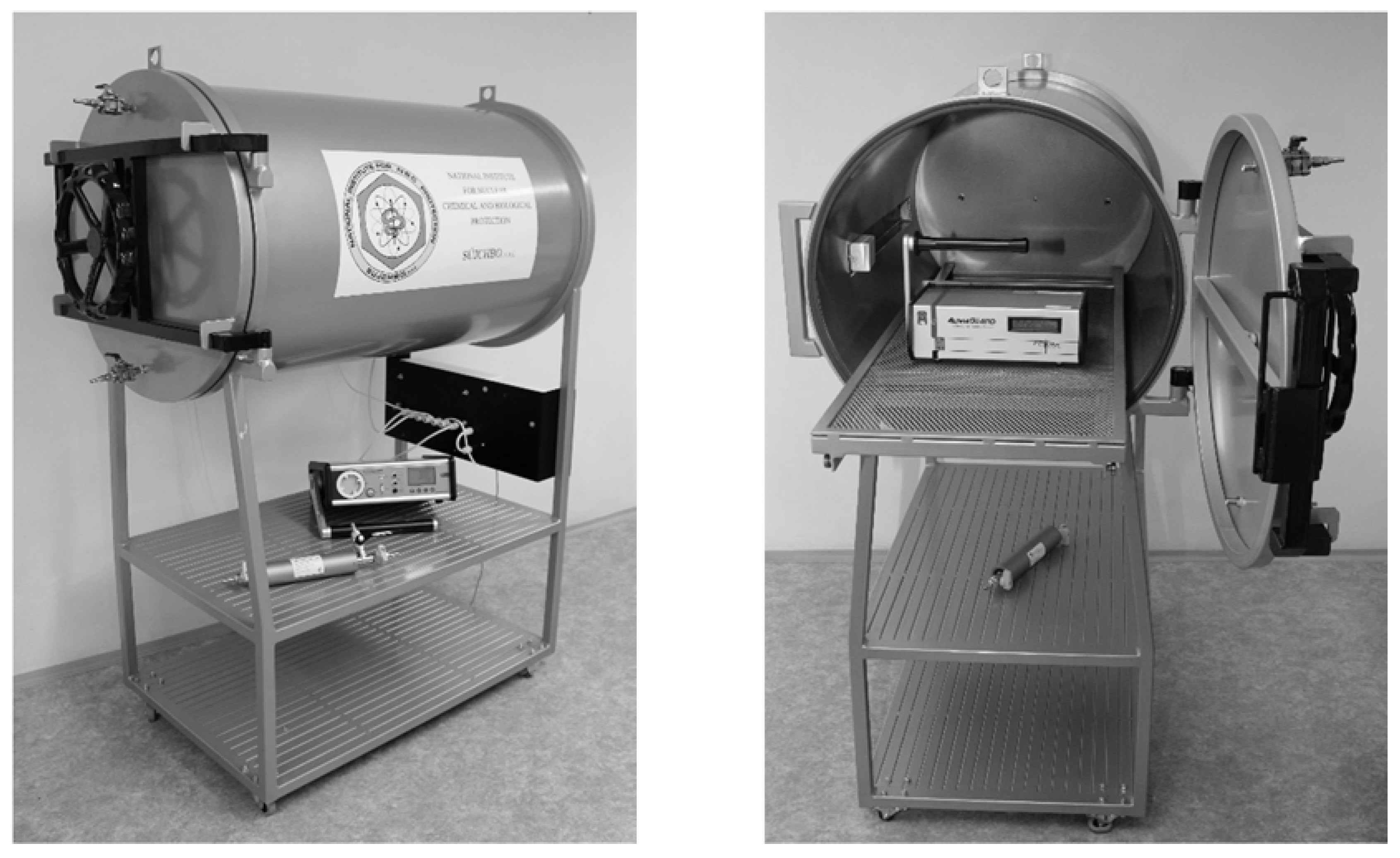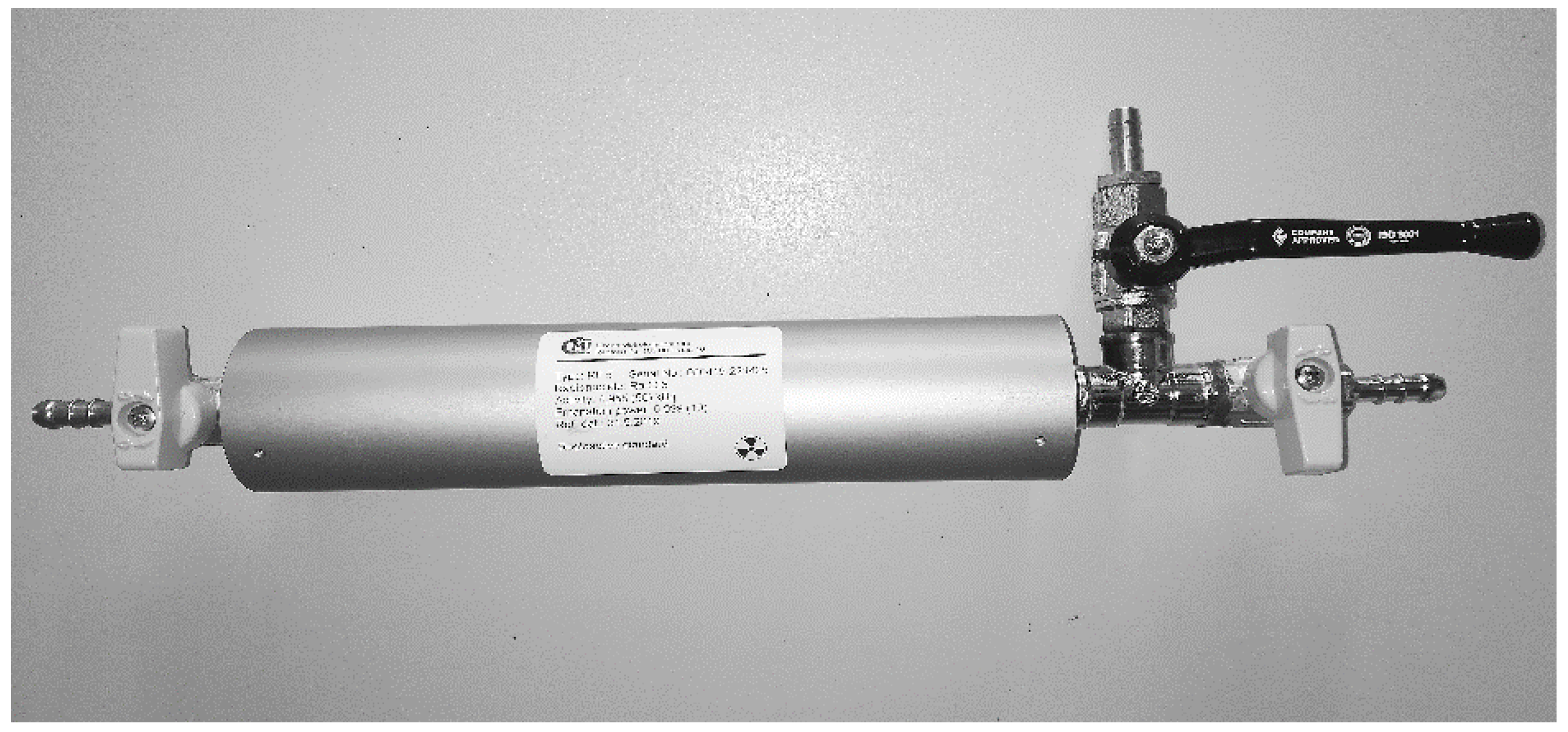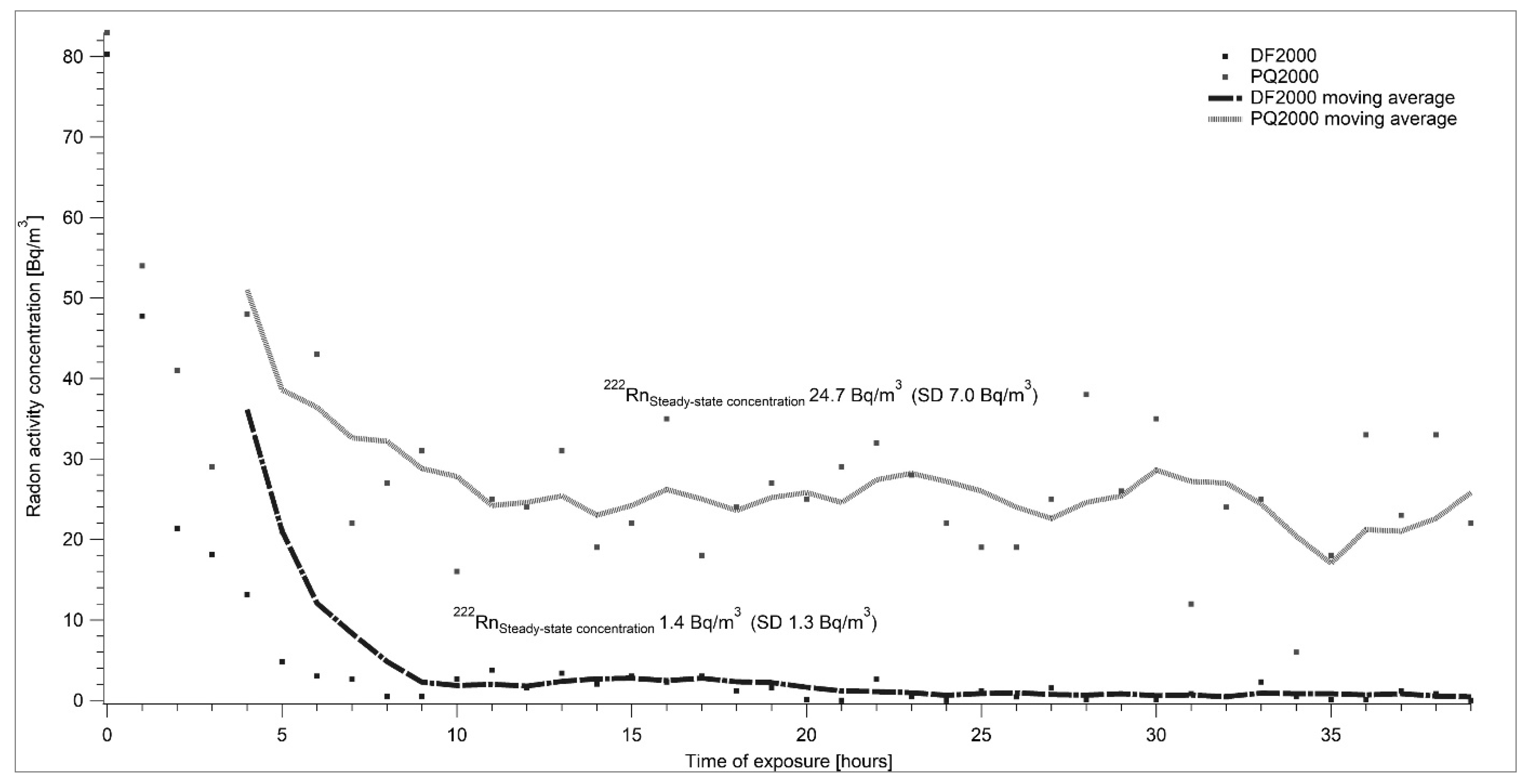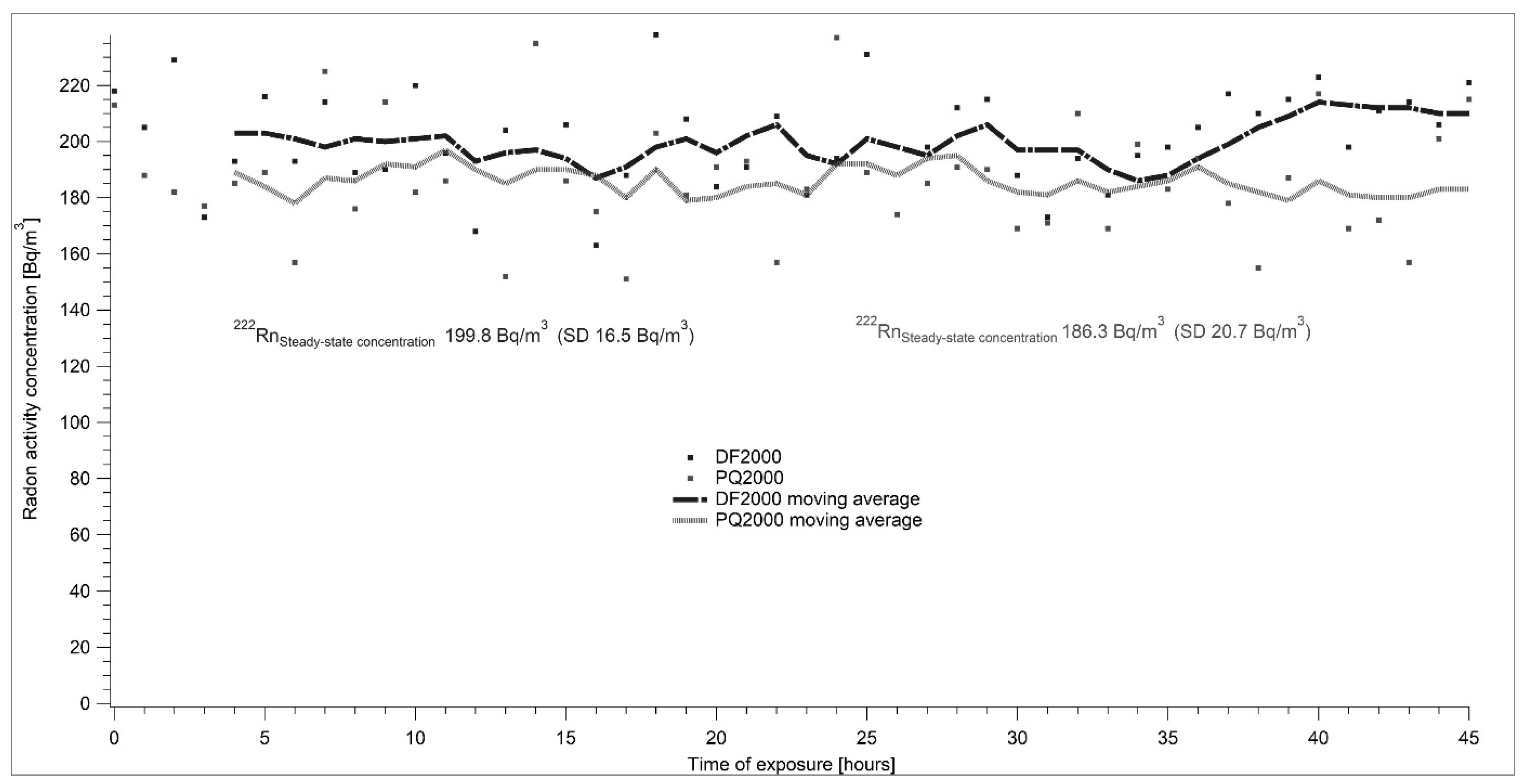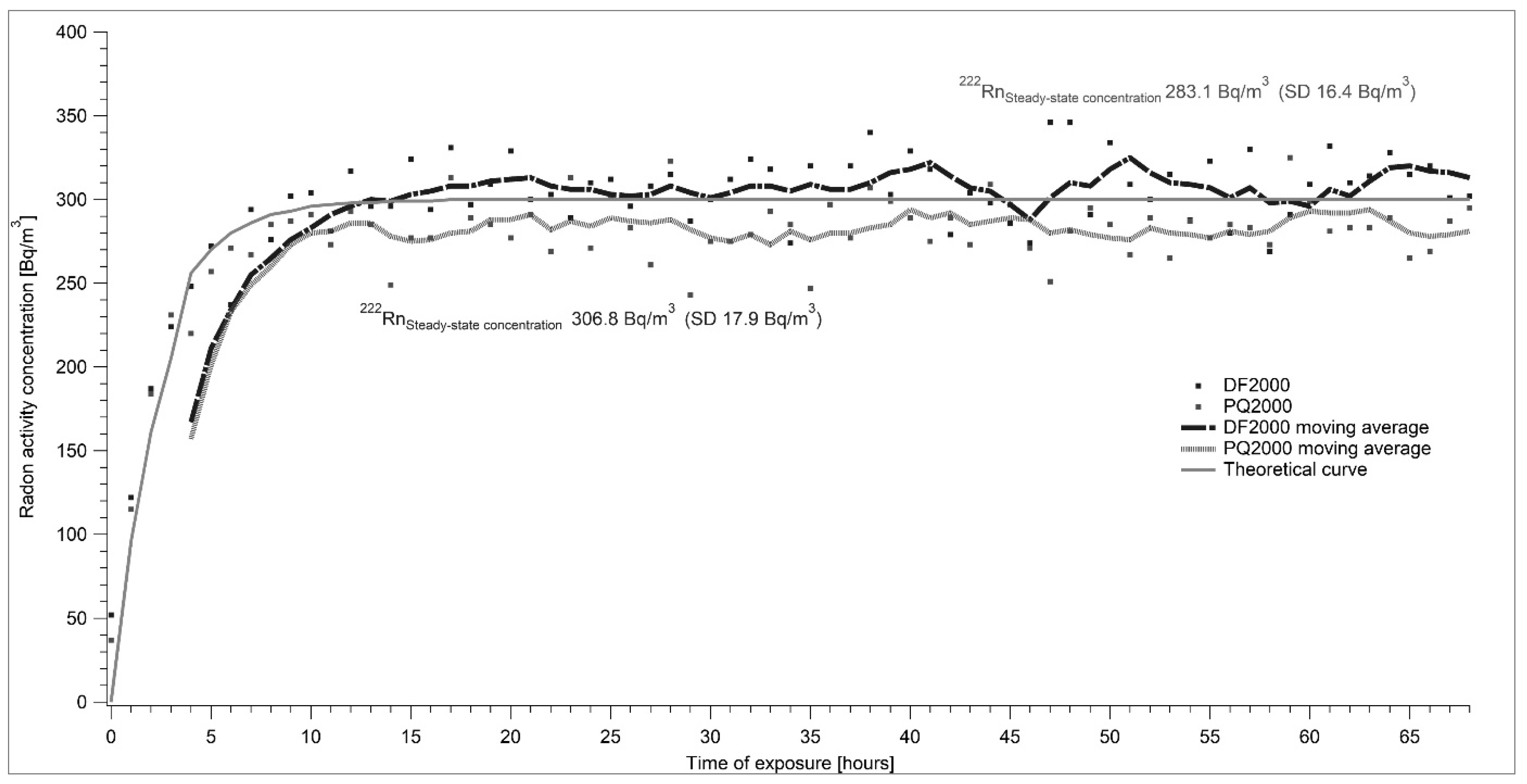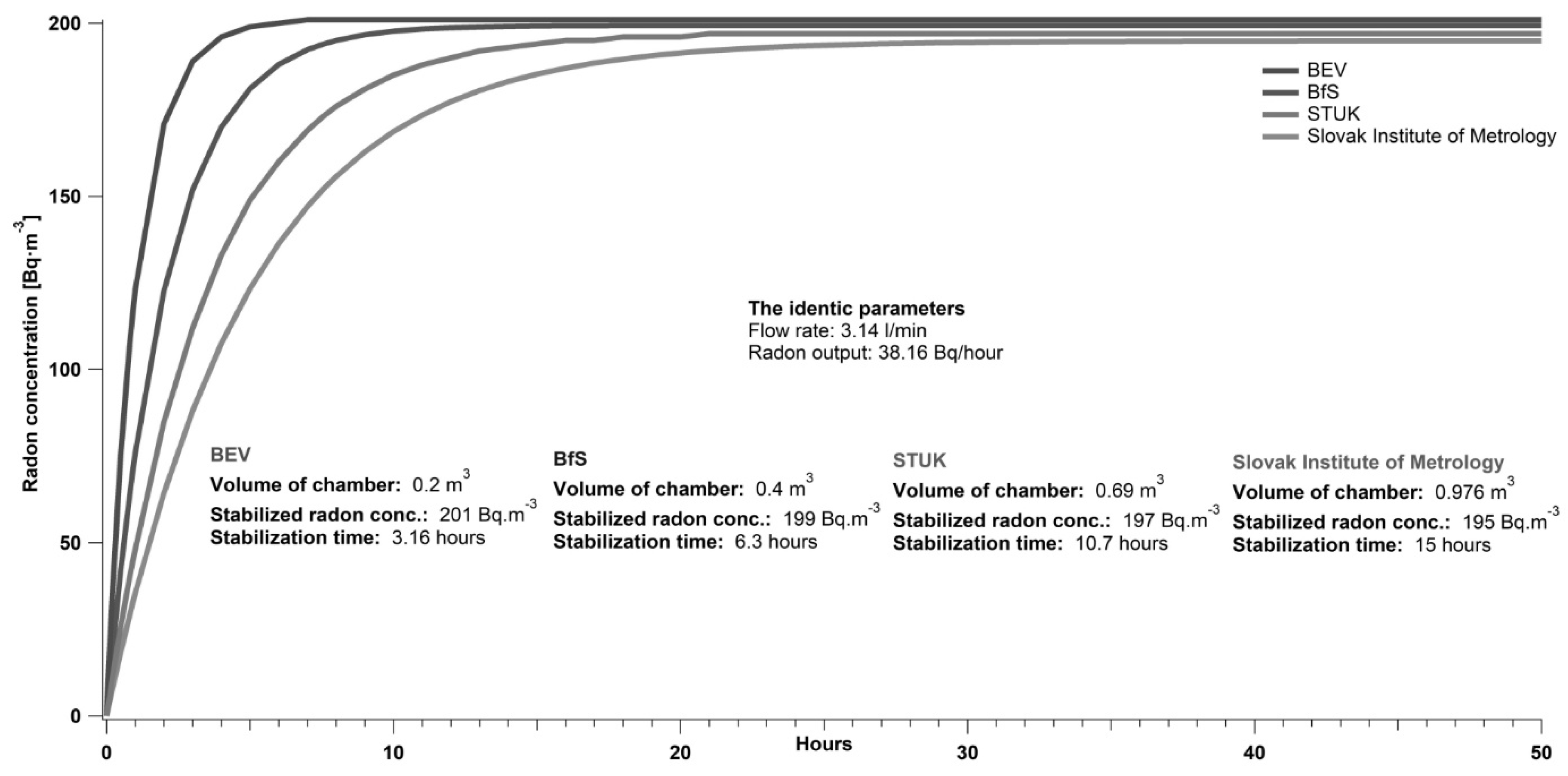1. Introduction
Radon 222 is a naturally occurring radioactive noble gas as a member of the natural uranium–radium family. The latter is found in variable amounts in rocks and soils. Radon comes through the cracks and spreads into the atmosphere of the dwellings and other indoor places. The amount of radium 226 in the ground and the porosity of bedrock affects the level of indoor radon activity concentration [
1].
Non-gaseous, short-lived radon-daughter products attached to aerosols are present in inhaled air. The settling of such aerosols in the respiratory tract leads to the alpha irradiation of the bronchial system [
1].
The WHO [
2] estimated that between 3% and 14% of all lung cancer cases in the world are caused by radon (or radon decay products, respectively) depending on the average of the radon level in the country. This corresponds to several thousand people dying per year of lung cancer caused by radon exposure in Europe.
Radon measurement techniques to evaluate the radon concentration in dwellings are simple, efficient and precise. The levels of relevant concentrations in European dwellings have been lowered (300 Bq·m
−3); however, there is still a need to develop and/or improve the accuracy of calibration procedures for existing commercial radon monitoring practices [
3,
4,
5].
The evaluation and calibration of measuring devices for radon and radon daughter products (RnDP) requires stable conditions of radon activity concentration. In the assignment of the Project 16ENV10 MetroRADON, keeping a stable radon activity concentration at a precise level for several days was the main goal of the development of new equipment for testing measuring devices at low-level radon activity concentrations.
2. Material and Methods
The newly developed equipment is a part of the Czech primary radon measurement device situated in SUJCHBO, v.v.i. Kamenna (Central Bohemia).
Figure 1 represents a simplified scheme of the equipment construction. In particular, the equipment consists of an airtight low-level radon chamber (LLRCH), a humidifier, a flow-through source of Rn-222 type RF 5 (Prague, CZE), a mass flow controller of the Bronkhorst
® EL-Flow type (Bethlehem—PA, USA), an aerosol filter and an air pressure vessel as the source of radon-free air.
In order to achieve a specific low-level radon concentration, it is necessary to ensure (1) a constant radon supply and (2) defined ventilation in the radon chamber. Because of the location of SUJCHBO, which is close to a former uranium mine, it is possible to measure an outdoor radon activity concentration in the range of tens or hundreds Bq·m−3. Therefore, it would not be possible to achieve a low-level radon activity concentration there without using a vessel with sufficiently radon-free air.
The air from the pressure vessel comes through the protective aerosol particle filter and the calibrated mass flow controller to the low-level radon source. The mixture of the air and radon comes through the humidifier to the radon chamber. The humidifier is installed into the construction to ensure that the measuring conditions are as real as possible.
The atmosphere homogeneity inside the radon chamber is ensured with the help of a continually regulated ventilator (the airflow speed can be set in the range 0.1–3.5 m·s−1). Sensors for the measurement of climatic conditions are placed inside the LLRCH.
2.1. Reference Level of Radon
During the equipment design, a model of constant radon input and constant ventilation was applied:
where
: radon activity concentration at time t (Bq·m−3);
: radon activity concentration at time zero (Bq·m−3);
λ: radon decay constant (h−1);
: air exchange intensity (h−1);
: time (h);
: radon input rate (Bq·h−1);
: volume of radon chamber (m3).
For the steady state (t = ∞) at a constant air exchange intensity and constant radon input rate, the following applies:
where
aV,Rn: radon activity concentration (Bq·m−3);
Qsettled: flow rate (m3⋅h−1);
M: molar mass (kg·mol−1);
p at Q calibration : air pressure 1013,25 (hPa);
R: molar gas constant (J·mol−1·K−1);
T at Q calibration : temperature 273,16 (K);
pat Rn confrontation : air pressure (Pa);
Tat Rn confrontation : temperature (K);
λRn : radon decay constant (h−1);
V: volume of radon chamber (m3);
RRn: radon emanation power (Bq·h−1).
2.2. Low-Level Radon Chamber
The low-level radon chamber (LLRCH) is made of steel, has a volume of 324 liters and has a cylindrical shape (
Figure 2). The whole chamber is grounded, and the inner surface is painted with a special color to avoid or suppress the deposition of the radon decay products on the walls.
The LLRCH is equipped with four sampling points for the connection of system components and to take samples of the inside air. These points are located in such a way that they allow sampling from different locations of the chamber.
The measuring device of climatic conditions enables the monitoring of temperature and air pressure by sensors placed inside and outside the radon chamber (the checking of possible under/overpressure with respect to natural air pressure in the laboratory) and the monitoring of relative humidity inside the radon chamber. A display reporting the on-line measured data is placed outside the chamber.
A movable drawer for the better manipulation of the used measuring devices is placed inside of LLRCH.
During many experiments which required the adjustment of a required low-level activity concentration, the air-tightness of the LLRCH was verified.
2.3. Low-Level Radon Source
In the 1950s, F. Kysela from the Institute for Research, Production and Utilization of Radioisotopes (ÚVVVR) in Prague created a primary set of 13 Ra-226 sources by filling RaBr2 into Thuringian glass tubes with a diameter of about 5 mm and wall thickness of 0.27 mm. Four of these emitters were compared to the standards of Prof. Otto Hoenigschmidt, deposited in Vienna, in 1957. The traceability was performed by Prof. Dr Berta Karlik from the Institut für Radiumforschung und Kernphysik. The remaining nine sources were compared to these four sources. The low-level radon emanation source used for the testing of LLRCH was created from one of the nine sources.
An emulsion of salts of fatty acids in silicone rubber was formed from the weighed standard solution. The emulsion was allowed to polymerize in a steel tray with the following dimensions: 70 × 30 mm. The activity of the standard as determined by the weight of the Ra-226 solution, the weight of the resulting emulsion and the losses (<0.1%). The whole process was controlled by weighing and gamma spectrometry on an HPGe detector. The 185 keV gamma-ray emission intensity was measured with the use of the standard solution, which confirmed excellent conformity with the tabulated value [
6].
Figure 3 shows the scheme of the low-level radon source. The source was constructed as a stainless-steel cylindrical case, supplied on the ends with ball valves and two aerosol filters connected on the output aperture of the valves. The steel tray with Ra-226 was placed in the middle of this cylindrical case, and radon was released from this thin layer.
The emanation coefficient of the source was determined by measuring the activity of the Rn-222 daughter products (Pb-214/Bi-214) and the activity of Ra-226 and was almost equal to 1. The detection efficiency of the gamma photons was calculated by the MCNP code (Monte Carlo N-Particle Transport).
The application of this source was the calibration of detectors for the activity measurements of Rn-222 in air. The source was operated in flow-through mode.
Figure 4 shows the real photo of the radon source developed by the CMI (Czech Metrological Institute, Prague) with an original label.
The emanation power of radon from a radium source depends on the humidity of air flowing through the source vessel. The air coming from the vessel is ultra-dried, which was confirmed by the placing of a humidifier into the equipment (behind the radon source) and by measuring the relative humidity in the chamber with and without the humidifier being connected. If the humidifier was not connected, the relative humidity in the chamber was very close to zero. In case of the humidifier being connected, the relative humidity in the chamber was in the range of 40%–60% depending on the setting of the humidifier.
2.4. Mass Flow Controller
Bronkhorst® model F-201CV (Bethlehem, PA, USA) mass flow controllers (MFCs) are suitable for the accurate measurement and control of flow ranges at operating pressures between a vacuum and 64 bar. The mass flow controller used in the equipment was calibrated by the Czech Metrological Institute. The MFC consists of a thermal mass flow sensor, a precise control valve and a microprocessor-based PC-board with signal and fieldbus conversion. The MFC is equipped with a digital high accuracy PC-board with a fast response.
4. Discussion and Conclusions
The low-level radon chamber of SUJCHBO, v.v.i. is a specific device developed for the calibration of measuring devices at a low-level radon activity concentration in the range of 100 Bq·m−3 to 300 Bq·m−3. Many tests have validated the air-tightness of the chamber and the possibility of adjusting a stable radon activity concentration to a required level for several days. A stable radon activity concentration is reached in several hours, depending on the required level of radon activity concentration and related intensity of air exchange. Generally, a higher required value of radon activity concentration means a lower intensity of air exchange and a much longer required time for stabilizing the radon atmosphere inside the chamber.
The level of radon activity concentration in the LLRCH can be changed continuously during the experiment by an operator. The climatic parameters are continuously monitored by the sensors placed inside the chamber.
The low-level radon source of the CMI (Czech Metrological Institute, Prague) can be used for different radon chambers with a volume between 200 and 1000 liters.

